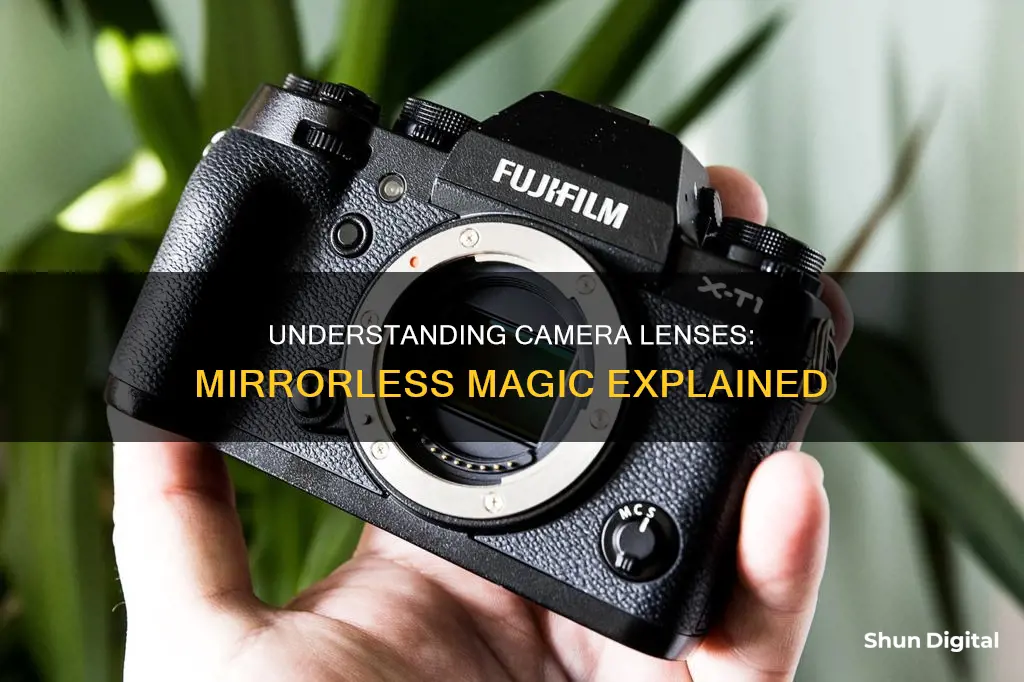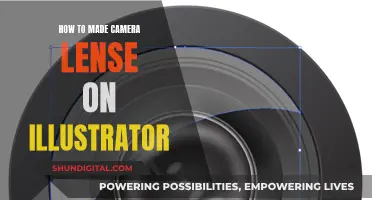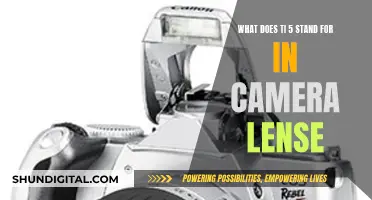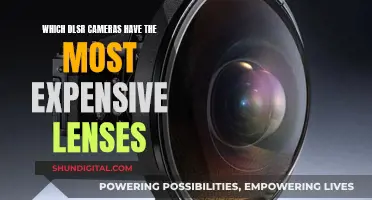
Mirrorless camera lenses are interchangeable units for mirrorless cameras, which photographers can use to easily upgrade their kit lenses and switch between lenses with different capabilities. Mirrorless cameras use zoom and prime lenses, with zoom lenses having a range of focal lengths and prime lenses having fixed focal lengths and wider apertures. A mirrorless camera is defined as a compact camera system with interchangeable lenses that uses a digital imaging sensor instead of a movable mirror and pentaprism to reflect a digital preview of what the lens is seeing through the electronic viewfinder (EVF).
| Characteristics | Values |
|---|---|
| Definition | Compact camera system with interchangeable lenses that uses a digital imaging sensor instead of a movable mirror and pentaprism |
| Main Selling Point | Lighter and more compact than DSLRs |
| Imaging Sensors | Full-frame, APS-C, Micro Four Thirds, and 1-inch |
| Autofocus (AF) | Phase detection, contrast detection, and hybrid autofocus system |
| Eye Focus and Subject Detection | Can lock onto a subject and recognize their eyes, including various types of animal eyes |
| Video Quality | Most include 4K video, with some featuring 6K and 8K video recording capability |
| Electronic Viewfinders (EVF) | Allow users to see in nearly complete darkness and are sharp, bright, and precise |
| High-Speed Shooting | Electronic shutters allow for dramatically fast frame rates, with the Nikon Z9 shooting at 120fps |
| Price Range | $400-500 for introductory models, with professional-level cameras at $6,000 and beyond |
What You'll Learn

Mirrorless cameras are lighter and more compact than DSLRs
Mirrorless cameras are often lighter and more compact than DSLRs, making them a convenient option for travel and everyday photography. This is due to the absence of a mirror mechanism, which is typically found in DSLRs. The mirrorless camera's biggest selling point is its compact size and portable weight.
The lack of a mirror system allows mirrorless cameras to be smaller, quieter, and lighter than DSLRs. They are also more mechanically simple, with fewer moving parts, which can make them more durable.
The weight and bulkiness of DSLRs can be a hindrance, especially when travelling or shooting in tight spaces. Mirrorless cameras, on the other hand, offer a more travel-friendly design without sacrificing image quality.
In addition to being lighter and more compact, mirrorless cameras also offer other advantages over DSLRs. For example, they have caught up in terms of the selection of available lenses. Many companies, such as Canon and Nikon, now offer adapters that allow the use of DSLR lenses on mirrorless bodies, giving photographers even more options.
The lightweight and compact design of mirrorless cameras is a significant advantage for photographers who need a discreet and unobtrusive camera for street or event photography.
What Shape Makes Camera Lenses Work?
You may want to see also

They use digital imaging sensors instead of a movable mirror
A defining feature of mirrorless cameras is their use of digital imaging sensors instead of a movable mirror. This is what sets them apart from DSLR cameras, which rely on a mirror to reflect an image onto an optical viewfinder.
In mirrorless cameras, the lens always shines light directly onto the image sensor, and what the camera sees is displayed on a screen for the photographer. This design has several implications for the functionality and performance of the camera.
Firstly, it allows mirrorless cameras to be smaller, lighter, and quieter than DSLRs. The absence of the mirror mechanism makes them more compact and portable, which is ideal for travel and everyday use.
Secondly, the use of digital imaging sensors affects how the camera processes light information. In mirrorless cameras, the light that comes through the lens goes straight to the sensor, which then transmits the digital information to the electronic viewfinder or LCD screen. This results in a digital preview of what the lens is seeing.
Additionally, mirrorless cameras typically use contrast detection autofocus systems, which achieve focus by measuring the contrast between pixels on the sensor. This is in contrast to DSLRs, which commonly use phase detection autofocus that relies on a mirror to divide incoming light into pairs of images.
The use of digital imaging sensors in mirrorless cameras also enables features such as eye focus and subject detection, where the camera can lock onto a subject's eyes or recognise different body movements.
Furthermore, the electronic viewfinders (EVFs) in mirrorless cameras have improved significantly over time. They now offer sharp, bright, and precise views, even in low-light conditions. This was a drawback of early mirrorless cameras but is no longer a limitation.
Overall, the use of digital imaging sensors in mirrorless cameras offers several advantages in terms of size, weight, image processing, autofocus, and viewfinder technology.
Sigma Lenses: Compatible with Full-Frame Cameras?
You may want to see also

They have interchangeable lenses
Mirrorless cameras have interchangeable lenses, just like DSLRs. This means that photographers can easily upgrade their kit lenses and switch between lenses with different capabilities.
The main types of mirrorless lenses are zoom and prime lenses. Zoom lenses have a range of focal lengths, while prime lenses have fixed focal lengths and wider apertures. Both types can be standard, macro, wide-angle, telephoto, or fisheye lenses.
A standard mirrorless lens captures images as the human eye sees them. Macro lenses are used for extreme close-up shots of small subjects, such as flowers, insects, or jewellery. Wide-angle lenses are ideal for landscape photography and group pictures as they capture panoramic views. Fisheye lenses produce extreme panoramic shots with curved edges. Telephoto lenses have long zoom capabilities, making them suitable for wildlife and sports photography.
When choosing a lens, it is important to consider the focal length and aperture range (f-stop number). Lenses are also designed for specific camera brands and sensor sizes, so it is important to ensure compatibility.
Disassembling and Cleaning Camera Lenses: A Step-by-Step Guide
You may want to see also

They have shorter battery life than DSLRs
Mirrorless cameras have shorter battery life than DSLRs due to their prolonged use of LCD and/or OLED viewfinder displays, and often smaller buffers (to save battery). The electronic viewfinder or LCD screen used to compose an image on a mirrorless camera uses more battery life than the standard viewfinder on a DSLR. The LCD screen on a mirrorless camera is also used for the majority of device settings, which uses more battery life than the physical, dedicated buttons on a DSLR.
Mirrorless cameras are also smaller, and so, by design, have smaller batteries. The circuitry of a mirrorless camera is constantly running, and the sensor and EVF or LCD must be powered continuously to maintain the Live-View function used for framing. In contrast, a DSLR can be used to frame while powered off, and its viewfinder requires no power. The status line of a DSLR, found below the viewfinder, uses segmented displays which consume very little power.
An EVF, on the other hand, has millions of pixels and requires a lot of power to operate and refresh at a high rate. The sensor, a fairly large chip, must also be read at a high rate, which is highly power-consuming. When using Live-View mode on a DSLR, the camera essentially becomes a large mirrorless camera, keeping the sensor on constantly and refreshing the LCD screen.
While mirrorless camera battery life is improving, DSLRs still come out on top. The entry-level Nikon D3500, for example, can take 1,550 shots per charge, whereas the Sony a6100 mirrorless camera is rated for 420 shots from the same battery.
Sigma Lenses: Compatibility Across Camera Brands
You may want to see also

They are mechanically simpler than DSLRs
Mirrorless cameras are mechanically simpler than DSLRs. This is because they do not use a mirror system, which allows them to be smaller, lighter, and quieter.
In DSLR cameras, light from the lens is directed to either the image sensor or the viewfinder using a mechanical movable mirror. This mirror sits behind the lens and is responsible for reflecting light up to a prism or additional mirrors and into the viewfinder, allowing the photographer to preview their shot. When the shutter button is pressed, the mirror flips up, the shutter opens, and the light hits the image sensor, capturing the final image.
On the other hand, mirrorless cameras do not have this mirror system. Instead, the lens always shines light directly onto the image sensor, and what the camera sees is displayed on a screen for the photographer. This design makes mirrorless cameras more compact and lighter than DSLRs. Additionally, the lack of a moving mirror allows for completely silent operation, as the mirror is no longer flipping up and down.
The mechanical simplicity of mirrorless cameras also extends to their autofocus systems. DSLRs typically use a separate phase-detect autofocus system located behind the mirror. However, when the mirror flips up to capture an image, this autofocus system is no longer accessible. Mirrorless cameras, on the other hand, use a single autofocus system for both the rear screen and viewfinder, resulting in faster and more accurate autofocus performance.
Furthermore, mirrorless cameras have an advantage when it comes to video capture. Their design makes them better suited for constant 'live view', which is essential for video recording. Additionally, camera manufacturers are focusing their video capture technologies on mirrorless cameras, making them the preferred choice for videography and filmmaking.
While mirrorless cameras offer mechanical simplicity and other benefits, it is important to consider some trade-offs. One drawback is their shorter battery life compared to DSLRs. This is because mirrorless cameras need to power the screen and sensor continuously, whereas DSLRs can shoot without the need for a live view. Additionally, the compact size of mirrorless cameras may result in smaller grips and controls, which can be less comfortable for users with larger hands.
Lending Camera Lenses: A Unique Library Offering
You may want to see also
Frequently asked questions
A mirrorless camera is a compact camera system that uses interchangeable lenses and a digital imaging sensor instead of a movable mirror to reflect what the lens is seeing through the electronic viewfinder (EVF). The absence of the mirror mechanism typically found in DSLR cameras makes mirrorless cameras lighter and more compact.
Mirrorless cameras use zoom and prime lenses. A zoom lens has a range of focal lengths, while prime lenses have fixed focal lengths and wider apertures. Both types can be standard, macro, wide-angle, telephoto, or fisheye lenses.
When choosing a mirrorless lens, consider the focal length, angle of view, prime vs. zoom, mount, f-stop or aperture, autofocus (AF), stabilization, optical quality, bokeh and distortion, handling, and manual focus.
To ensure compatibility, you need to match the lens and camera sensor sizes. Use full-frame lenses with full-frame cameras, and full-frame or APS-C lenses with APS-C sensors. Additionally, consider the lens mount, as manufacturers make lenses specifically for their camera mounts.







